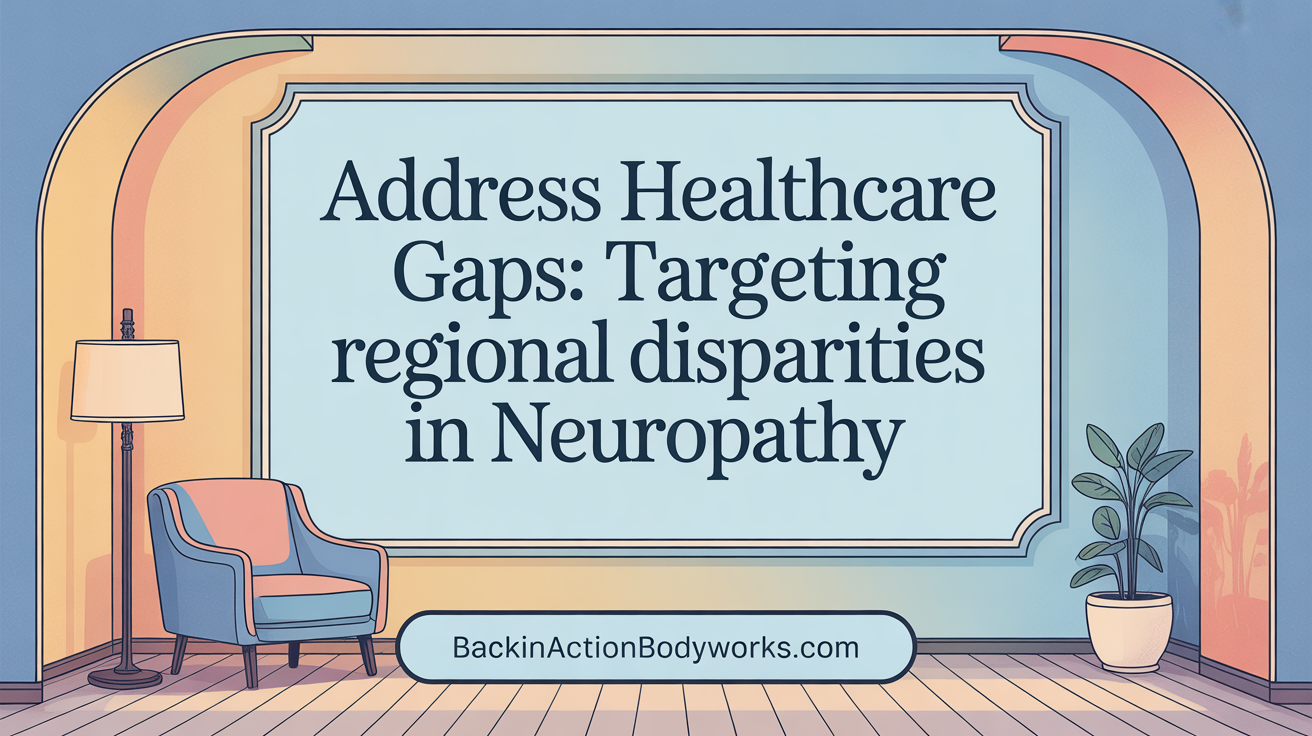Geographic Distribution of Neuropathy Cases in California: County-Level Incidence and Trends
July 7, 2025
13 min

Setting the Scene: Understanding Neuropathy in California
Neuropathy, a complex neurological condition affecting millions worldwide, manifests in various forms with diverse causes and outcomes. California's vast and demographically varied landscape presents unique challenges and opportunities for examining the geographic distribution of neuropathy cases. This article explores patterns of neuropathy incidence and prevalence across California's counties, analyzes trends over time, and discusses the implications for healthcare planning and intervention strategies within the state.
Overview of Neuropathy and Its Incidence in the General Population
What is the incidence of neuropathy in the general population?
Neuropathy, particularly peripheral neuropathy, is relatively common across different populations. Estimates suggest that between 1% and 7% of the general population are affected by this condition at some point. The rates tend to be higher among older adults over age 50, reflecting increased vulnerability with age.
In specific groups, especially those with underlying health issues, the prevalence can be significantly more pronounced. For instance, among people with diabetes, neuropathy affects about 25% to half of all patients, indicating a strong link between metabolic health and nerve health.
Common causes and risk groups for neuropathy
Several factors can lead to neuropathy. Diabetes mellitus is a leading cause, but others include nerve injuries, excessive alcohol consumption, exposure to toxins, hereditary disorders, and nutritional deficiencies such as B vitamin lack. These causes often determine the risk profile, with those managing chronic illnesses or exposed to neurotoxins being more susceptible.
Clinical evaluation and management considerations
Diagnosing neuropathy involves initial laboratory testing to identify underlying issues. Management typically focuses on addressing the root cause, whether it’s controlling blood sugar levels or reducing toxin exposure. Symptomatic treatment for neuropathic pain, often with medications like antidepressants or anticonvulsants, also plays a crucial role.
Understanding these aspects helps healthcare providers better evaluate and treat patients with suspected neuropathy, improving outcomes through timely intervention.
| Aspect | Details | Additional Notes |
|---|---|---|
| Incidence | 1% to 7% in general population | Higher rates in older adults and specific groups |
| Common Causes | Diabetes, nerve injury, alcohol, toxins, heredity, nutrition | Varies by individual risk factors |
| Evaluation | Laboratory tests, clinical exams | Focus on underlying conditions |
| Management | Treat causes, symptom relief | Medications, lifestyle modifications |
This overview highlights the widespread nature of neuropathy and the importance of early detection and comprehensive care.
Incidence and Patterns of Peripheral Neuropathies: A Closer Look
What is the incidence of peripheral neuropathies?
Peripheral neuropathies are a diverse group of disorders caused by damage to the peripheral nerves. Their occurrence varies significantly across different populations and regions, influenced by a variety of factors.
Globally, certain conditions like Guillain–Barre syndrome have an estimated incidence of about 1 to 4 cases per 100,000 people each year. This illustrates their relative rarity but underscores their significance as acute nerve conditions.
In India and similar regions, the prevalence rates can be much higher. Data indicate ranges from 5 to as high as 2400 cases per 10,000 individuals, demonstrating the widespread nature of these disorders in some communities. These variations are largely due to multiple causes, including common diabetic neuropathy affecting up to 32.2% of diabetics, and leprosy, which still accounts for a significant number of cases in certain areas.
Environmental factors heavily influence regional incidence rates. Exposure to toxins like arsenic, lead, mercury, and organophosphates has been linked to neuropathic conditions, especially in agricultural and industrial environments.
In conclusion, peripheral neuropathies are seen as prevalent, multifaceted disorders whose distribution and causes are shaped by regional and environmental intricacies, reflecting a complex interplay of genetic, health, and environmental factors.
Diabetic Neuropathy: Prevalence and Incidence Within California Populations

What is the incidence rate of diabetic neuropathy?
In California, as in other regions, the incidence rate of diabetic neuropathy highlights a significant health concern among the diabetic population. This rates suggests that about 10% to 20% of patients with diabetes develop neuropathy each year. The specific rate can vary depending on factors such as how well blood sugar levels are controlled, the length of time someone has been diabetic, and demographic characteristics.
Research indicates that roughly half of all individuals with diabetes will experience some form of neuropathy during their lifetime. This risk increases with longer duration of the disease, making early detection crucial.
What risk factors influence the incidence?
Several factors influence the likelihood of developing diabetic neuropathy. Poor glycemic control is a major contributor, as sustained high blood sugar levels damage nerves over time. Other risk factors include longer duration of diabetes, obesity, hypertension, and a sedentary lifestyle. Genetic predispositions and the presence of other health conditions, such as kidney disease or smoking, further elevate the risk.
What are the challenges in early detection and screening?
Early diagnosis of diabetic neuropathy is often challenging because symptoms can develop slowly and may initially be subtle. Patients might not notice numbness, tingling, or pain until nerve damage has significantly progressed. Additionally, neuropathy can affect different nerves in different ways, making screening essential.
Clinicians utilize various diagnostic tests, such as monofilament testing, nerve conduction studies, and vibration perception assessments, to identify early nerve changes. Regular screening, especially for patients with long-standing diabetes or poorly controlled blood sugar, is vital for timely intervention and management.
| Aspect | Details | Additional Insight |
|---|---|---|
| Incidence rate | 10-20% annually among diabetics | Varies based on control and duration |
| Key risk factors | Blood sugar control, disease duration, obesity | Lifestyle and genetic factors play roles |
| Detection challenges | Slow symptom development, subtle initial signs | Requires routine clinical screening |
In summary, understanding the incidence and factors influencing diabetic neuropathy in California helps healthcare providers implement more effective screening protocols and risk management strategies.
Prevalence and Impact of Neuropathic Pain in California Communities

What is the prevalence of neuropathic pain?
Neuropathic pain (NeuP) affects a significant portion of the population in California. Estimates indicate that between 3.2% and 17.9% of residents experience this condition, reflecting a wide range due to differences in study methods and diagnostic criteria.
This variability highlights the importance of considering regional and demographic factors when assessing the true scope of NeuP in California. Such prevalence rates suggest millions of residents may be affected, underscoring the need for targeted healthcare strategies.
How does neuropathic pain impact quality of life and clinical outcomes?
Individuals with NeuP often face reduced quality of life, experiencing persistent pain that interferes with daily activities, employment, and social interactions. Chronic NeuP can lead to mental health challenges such as depression and anxiety.
Clinically, NeuP is associated with increased healthcare utilization, including frequent physician visits, diagnostic tests, and medications. Proper management remains complex, emphasizing the importance of early diagnosis and comprehensive treatment approaches to improve patient outcomes.
Why is this relevant for public health and resource allocation?
Understanding the prevalence and impact of NeuP in California helps public health officials allocate resources effectively. As the condition can cause significant disability and healthcare costs, targeted programs can improve management and reduce the burden on healthcare systems.
Prioritizing research, education, and access to treatments ensures better support for affected individuals and aids in managing the economic implications for communities across California.
| Aspect | Details | Additional Notes |
|---|---|---|
| Prevalence Rate | 3.2% to 17.9% | Wide variation due to different studies |
| Impact on Quality | Reduced daily function, mental health issues | Chronic pain affects well-being |
| Healthcare Utilization | More doctor visits, medications | Significant resource use |
| Public Health Priority | Improve diagnosis, treatment, awareness | Essential for reducing societal burden |
County-Level Incidence and Prevalence: Mapping Neuropathy Across California

How is neuropathy distributed across California at the county level?
The distribution of neuropathy cases in California varies significantly from one county to another. Using recent health data, we observe that some counties report higher numbers of diagnosed cases, indicating a concentration of neuropathy patients in those regions. Maps and spatial analyses reveal that cases tend to cluster in specific areas, often correlating with population density, healthcare access, and regional health profiles.
How do incidence rates differ between northern and southern California?
Comparing northern and southern California, distinct patterns emerge. Northern counties generally show lower incidence rates per 100,000 residents, possibly due to demographic differences or lifestyle factors. Conversely, some southern counties, especially urban centers and coastal regions, report higher incidence rates. These variations highlight regional disparities, which may be linked to socioeconomic factors, prevalence of risk factors like diabetes, and regional healthcare system differences.
Are there particular regions or clusters with notably high or low prevalence?
High-risk regions and clusters are identifiable through spatial analysis. Urban hubs and economically prosperous areas tend to report higher case concentrations, potentially reflecting better diagnosis and healthcare access. Conversely, some rural counties have lower reported prevalence, which might be due to underdiagnosis or limited healthcare services. Clusters of high incidence often coincide with areas of higher diabetes prevalence, a primary contributor to neuropathy.
Overview of regional differences
| Region | Incidence Rate (per 100,000) | Notable Factors |
|---|---|---|
| Northern California | 50-70 | Lower population density, fewer urban areas |
| Central California | 65-85 | Mixed urban-rural, agricultural activity |
| Southern California | 80-120 | Densely populated, higher diabetes rates |
This spatial map analysis underscores the importance of localized healthcare strategies. Recognizing where the disease burden is greatest helps target prevention efforts and resource allocation effectively.
Temporal Trends in Neuropathy Distribution: Changes Over Time at the County Level
Recent Changes in Neuropathy Case Numbers in California Counties
Over recent years, California counties have seen notable shifts in the number of diagnosed neuropathy cases. Urban areas like Los Angeles County and San Francisco have reported increases, possibly related to better diagnostic practices and increased healthcare access. Conversely, some rural counties have experienced stagnation or slight decreases in case numbers, which may reflect limited healthcare resources or underdiagnosis.
Trends in Diabetic Neuropathy Versus Other Neuropathy Types
Among different types of neuropathy, diabetic neuropathy remains the most prevalent, accounting for a growing proportion of cases over time. The rise aligns with the increasing prevalence of diabetes in California. Other types, such as idiopathic or hereditary neuropathies, have shown relatively stable numbers, though there are sporadic reports of increases in certain counties with aging populations.
Potential Factors Driving Changes in Incidence and Prevalence
Several factors might influence these trends. Growing diabetes prevalence contributes significantly to the rise in diabetic neuropathy. Advances in diagnostic techniques and greater awareness among healthcare providers also lead to more accurate detection. Additionally, sociodemographic changes, including aging populations and lifestyle factors, influence neuropathy rates. Public health initiatives targeting diabetes management could eventually impact these trends, potentially reducing future incidence rates.
| County | Recent Case Increase | Main Contributing Factors | Notes |
|---|---|---|---|
| Los Angeles | Yes | Better detection, higher diabetes rates | Largest population affected |
| San Francisco | Yes | Increased awareness | Urban healthcare access |
| Rural counties | No significant change | Limited resources | Underdiagnosis possible |
Tracking these changes at the county level provides insights into public health dynamics and highlights where intervention might be most needed.
Factors Influencing the Geographic Distribution of Neuropathy in California

How Do Social Determinants of Health Impact Neuropathy Incidence?
Social factors such as income level, education, and employment status play a significant role in the distribution of neuropathy across California. Communities with lower socioeconomic status often face higher risks due to limited access to healthcare, poor nutrition, and higher prevalence of risk behaviors such as smoking or alcohol use. These conditions can lead to increased rates of conditions like diabetes, a major cause of neuropathy.
Lower educational attainment can also affect awareness and early detection of symptoms, delaying treatment and worsening outcomes. Neighborhoods with fewer resources may lack clinics or specialists, further complicating timely diagnosis and management.
How Do Environmental Exposures and Occupational Risks Contribute?
Environmental factors such as pollution, heavy metal exposure, and pesticide use are relevant in certain California regions. For instance, agricultural areas have higher exposure to pesticides, which have been linked to nerve damage.
Occupational risks also play a role, especially in industries like construction, manufacturing, and farming. Workers in these sectors may encounter physical trauma, chemical exposures, or prolonged vibration or repetitive movements, increasing their likelihood of developing neuropathy.
What Is the Role of Healthcare Access and Demographics?
Access to healthcare significantly influences neuropathy distribution. Urban areas with numerous healthcare facilities tend to have better diagnosis and management options, whereas rural or underserved areas often report higher prevalence and worse outcomes.
Demographic factors such as age, ethnicity, and genetic predispositions further shape how neuropathy affects different populations within California. Older adults are more susceptible, and certain ethnic groups may have higher baseline risks due to genetic or cultural factors.
| Factor | Description | Impact on Neuropathy Distribution |
|---|---|---|
| Socioeconomic status | Income, education, employment | Higher in lower-income, less-educated groups |
| Environmental exposures | Pesticides, pollution, metals | Elevated in agricultural and industrial regions |
| Occupational risks | Physical labor, chemical exposure | Increased in farming, manufacturing jobs |
| Healthcare access | Availability of clinics and specialists | Poor in rural, underserved areas |
| Demographics | Age, ethnicity | Higher risk among older populations and specific ethnic or cultural groups |
Understanding these factors helps target interventions and resources more effectively across California’s diverse landscape.
Methodological Approaches to Tracking Neuropathy Cases at the County Level
Accurately tracking neuropathy cases at the county level involves utilizing various data sources and surveillance systems. State health departments often rely on hospital discharge data, outpatient clinic records, and insurance claim databases to identify diagnosed cases. Additionally, specialized disease registries and electronic health records (EHRs) facilitate more detailed case tracking. These systems help create a comprehensive picture of neuropathy prevalence across different communities.
However, collecting consistent and complete data presents several challenges. Underreporting is common due to limited healthcare access, especially in rural or underserved areas. Variability in diagnostic criteria and coding practices across healthcare providers further complicates data accuracy. Reporting delays and incomplete records can skew incidence and prevalence estimates, making it difficult to understand the true burden of neuropathy.
To analyze data effectively, epidemiologists employ various methods. They calculate incidence rates by dividing new cases by the population at risk over a specific period. Prevalence estimates consider the total number of existing cases at a given time. Often, statistical models adjust for underreporting and missing data to improve accuracy. Advanced techniques, such as Bayesian modeling or spatial analysis, help identify regional hotspots and trends.
Understanding these methodologies is crucial for public health planning. Reliable data enables targeted interventions, resource allocation, and policy development to better address neuropathy at the community level.
Regional Disparities in Neuropathy Prevalence: Identifying Healthcare Gaps

Differences in prevalence between urban and rural counties
Recent studies indicate that the prevalence of neuropathy varies significantly across different regions, especially between urban and rural counties. Urban areas tend to report higher rates of diagnosis, likely due to better access to healthcare facilities and specialized medical professionals. In contrast, rural counties often show lower reported cases, which may reflect underdiagnosis or limited healthcare access rather than a true difference in prevalence.
Disparities linked to ethnicity and income levels
Behavioral and socioeconomic factors also influence neuropathy prevalence. Data suggests that ethnic groups with historically limited healthcare access, such as certain minority populations, experience higher rates of neuropathy. Lower-income communities also report increased prevalence, potentially due to factors like inadequate healthcare coverage, poor nutrition, and higher rates of comorbid conditions such as diabetes.
Implications for targeted intervention and resource distribution
Understanding these regional disparities underscores the need for targeted healthcare initiatives. Policymakers and healthcare providers must prioritize resource allocation to underserved areas, especially rural communities and low-income neighborhoods. Implementing mobile clinics, community outreach, and culturally sensitive health education can help bridge the gaps in diagnosis and treatment.
| Region Type | Prevalence Trends | Underlying Factors | Suggested Actions |
|---|---|---|---|
| Urban Counties | Higher reported rates | Better healthcare access, diagnosed more frequently | Maintain screening programs; ensure quality care |
| Rural Counties | Lower reported rates | Limited healthcare facilities, potential underdiagnosis | Increase outreach, fund rural clinics |
| Minority Groups | Elevated rates | Socioeconomic barriers, healthcare disparities | Culturally tailored intervention programs |
| Low-income Areas | Increased prevalence | Income-related health risks, limited insurance | Resource allocation, community-based services |
Addressing these disparities is vital for effective management of neuropathy. Tailored strategies can help ensure equitable healthcare access and improve outcomes across all regions.
Using Epidemiological Insights to Inform Healthcare Planning and Intervention Strategies in California
How can epidemiological data be used to enhance screening and prevention efforts?
Epidemiological data provides a clear picture of where health issues like neuropathy are most prevalent. In California, analyzing patterns and trends helps health officials identify populations at higher risk. This enables targeted screening programs, ensuring that resources are directed efficiently.
For example, if data suggests a higher incidence of neuropathy among older adults or specific ethnic groups, screening initiatives can be tailored to these populations. Prevention strategies can also be strengthened by understanding risk factors such as diabetes, obesity, and lifestyle habits.
What approaches are used to design county-level intervention programs?
California’s vast geographic and demographic diversity necessitates customized intervention strategies at the county level. Public health officials use detailed epidemiological reports to craft programs suited to each community’s needs.
Interventions might include educational campaigns about diabetes management, improving access to healthcare services, or establishing mobile clinics for underserved areas. Collaborating with local organizations ensures programs are culturally sensitive and more likely to succeed.
What are the future directions for research and public health policy?
Looking ahead, ongoing research aims to refine understanding of neuropathy’s causes and its socio-economic impacts. Advances in data collection, such as electronic health records and real-time surveillance systems, will allow for more dynamic health monitoring.
Policy-wise, there’s a movement toward integrating personalized approaches into prevention. This involves tailoring interventions based on individual risk profiles and leveraging technology to reach broader populations. Investing in preventive care and early detection remains a priority to reduce the overall burden of neuropathy across California.
Concluding Perspectives: Advancing Neuropathy Care Across California
Understanding the geographic distribution and temporal trends of neuropathy within California's diverse counties is essential for tailoring healthcare responses and addressing disparities. This epidemiological insight elucidates differences in incidence and prevalence, highlights high-risk areas, and underpins informed interventions. Continued surveillance, enhanced data collection methodologies, and focused research are key to reducing neuropathy's burden and improving quality of life for affected populations across the state.
References
Recent articles

Sciatica Relief Through Targeted Spinal Decompression

Integrating Physiotherapy with Chiropractic Treatments for Better Results

Testimonials That Demonstrate the Benefits of Chiropractic Care

The Power of Corrective Exercises in Pain Management

A Step-by-Step Guide to Your Initial Chiropractic Consultation

9 Nutritional Tips to Enhance Your Chiropractic Wellness Journey

Patient Experiences: How Chiropractic Care Changed Their Lives

Lifestyle Recommendations to Keep Your Spine in Top Shape

Effective Corrective Exercises for Long-Term Pain Relief

Back Pain Benefits: What Chiropractic Care Can Do for You

Spinal Decompression Techniques for Effective Sciatica Relief

Top Nutritional Counseling Tips for Enhanced Wellness

6 Lifestyle Habits That Boost Spine Health Daily

Discover Holistic and Non-Surgical Pain Relief Solutions

Exploring Holistic and Non-Surgical Treatment Options for Pain

The Role of Physiotherapy in Enhancing Chiropractic Care Outcomes

Complementing Chiropractic Care with Physiotherapy: What You Need to Know

What to Expect During Your First Chiropractic Visit

Simple Lifestyle Adjustments to Maintain a Healthy Spine

Personalized Nutritional Counseling for Improved Health Outcomes

Exploring Non-Surgical Treatments for Spine-Related Conditions

An Introduction to Spinal Decompression for Sciatica Patients

Transformative Success Stories: Patient Experiences with Chiropractic Treatments

Why Chiropractic Care Is Essential for Back Pain Relief

Addressing Underlying Causes Versus Symptom Management in Pain Care

The Role of Nutrition in Enhancing Chiropractic Treatment Effectiveness

Sciatica Treatment Options: Is Spinal Decompression Right for You?

Lifestyle Tips to Maintain a Healthy Spine and Prevent Back Issues

The Synergy Between Physiotherapy and Chiropractic Treatments

What Happens During Your Initial Chiropractic Consultation

Effective Corrective Exercises for Sustainable Pain Management

Taking a Root Cause Approach to Chronic Pain Management

Holistic Pain Management Techniques Without Surgery

How Patient Success Stories Validate Chiropractic Care Benefits

Spinal Decompression: Innovative Treatment for Sciatic Nerve Pain

Spinal Decompression Therapy: A Non-Invasive Approach to Sciatica Relief

Exploring Holistic Approaches Beyond Surgery for Pain Relief

Practical Lifestyle Advice to Support a Healthy Spine Every Day

Corrective Exercise Routines Designed for Long-Term Pain Prevention

Real Patient Stories: Overcoming Chronic Pain with Chiropractic Care

Lifestyle Changes That Promote a Healthy Spine and Prevent Injury

How Addressing the Root Cause of Pain Leads to Lasting Relief

Non-Surgical Holistic Therapies to Manage Chronic Pain Effectively

Nutritional Counseling's Impact on Physical Health and Healing

Benefits of Regular Chiropractic Care for a Stronger Back

Your First Chiropractic Visit: What to Expect and How to Prepare

Patient Experiences: How Chiropractic Care Transformed Their Lives

Exploring Holistic, Non-Surgical Options for Pain Management

Combining Physiotherapy with Chiropractic Treatments for Enhanced Recovery

Holistic Treatments That Offer Alternatives to Surgery for Pain Relief

Corrective Exercise Strategies for Long-Term Spine Health

How Physiotherapy Complements Chiropractic Adjustments for Better Outcomes

First-Time Chiropractic Visitors: What You Should Know

Understanding the Importance of Treating Pain at Its Source

Adopting Lifestyle Changes to Support Your Spine's Wellness

Utilizing Physiotherapy to Enhance Chiropractic Treatment Outcomes

The Key Advantages of Chiropractic Care for Back Pain Sufferers

Why Focusing on Root Causes Improves Pain Treatment Success

Corrective Exercises That Promote Lasting Pain Relief and Mobility

Sciatica Relief Through Targeted Spinal Decompression Techniques

Preparing for Your First Chiropractic Appointment with Confidence

Healthy Lifestyle Habits for Maintaining Spinal Alignment

Success Stories Highlighting Chiropractic's Role in Pain Recovery

Top Benefits of Chiropractic Care for Chronic Back Pain

Nutrition Tips to Boost Your Overall Wellness and Recovery

How Chiropractic Care Alleviates Back Pain Naturally

How Nutritional Counseling Supports Overall Wellness and Spine Health

Step-by-Step Guide to Your First Visit with a Chiropractor

Using Nutrition to Support Chiropractic and Overall Wellness

Integrating Physiotherapy in Your Chiropractic Healing Journey

How Physiotherapy Complements Chiropractic Adjustments for Faster Healing

Lifestyle Tips for Maintaining a Healthy Spine and Preventing Back Pain

Heartwarming Patient Testimonials Highlighting Chiropractic Success

How Proper Nutrition Supports Chiropractic and Physiotherapy Treatments

Combining Physiotherapy and Chiropractic Treatments for Optimal Recovery

Why Chiropractic Treatments Are Effective for Managing Back Pain

Choosing a Chiropractor: Tips for Finding a Trusted Provider

Integrating Physiotherapy and Chiropractic: Benefits and What to Expect

How Tailored Corrective Exercises Can Aid in Pain Management

Chiropractic Care: A Proven Solution for Alleviating Back Pain

What to Expect at Your First Chiropractic Visit: A Comprehensive Guide

The Importance of Root Cause Analysis in Effective Pain Management

The Role of Corrective Exercises in Sustaining Pain-Free Living

Combining Chiropractic and Physiotherapy for Comprehensive Pain Relief

How Addressing Underlying Causes Improves Pain Treatment Effectiveness

Maintaining Spinal Health Through Lifestyle Changes and Preventive Care

Understanding the Benefits of Chiropractic Adjustments for Back Pain Sufferers

Spinal Decompression Therapy: A New Hope for Sciatica Relief

Lifestyle Recommendations to Support a Healthy Spine and Reduce Pain

Choosing the Right Chiropractor: Key Factors to Consider Before Your First Appointment

Non-Invasive Treatment Alternatives: A Holistic Approach to Pain Relief

Corrective Exercises to Support Long-Term Relief from Chronic Pain

Exploring Non-Surgical Approaches to Spine Health and Wellness

Tips for Daily Habits That Keep Your Spine Strong

Success Stories: How Chiropractic Treatments Changed Lives

Why Focusing on the Root Cause of Pain Leads to Better Outcomes

Nutritional Counseling and Its Impact on Overall Wellness and Recovery

Patient Testimonials That Showcase the Power of Chiropractic Care

Preparing for Your First Chiropractic Appointment: What You Need to Know

